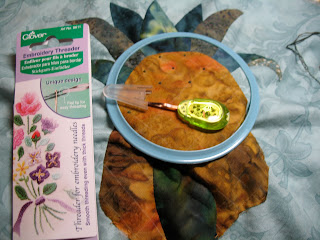I can enjoy a quilt if the color is not my personal taste or if I don't care for a fabric print. However, for a piece to work, the value must be on target. If you would like to read more about the importance of value, read my blog entry I Owe, I Owe, It's Off to Blog I Go. For a general color theory refresher and how value and color work hand in hand, you may also wish to read Color Theory for Quilters Exposed.
Value is not just limited to fabric choices. It's also very important when choosing embellishments. Waterlilies is a small wall hanging that is part of my Tropical Botanical series. It has been kicking around my UFO pile since 2002. I had never been able to finish it because I had never been able to decide on the embroidery thread. Nothing I tried looked right. I have ripped the embroider out of the lily pads and the stems at least half a dozen times if not more. I dragged the piece to the Quilt Festival in Houston in 2003 and the AQS show in Paducah in 2004 desperate to find the right color floss, thread, anything to finish the wall hanging. In 2005, I put it away.
Fortunately, as quilt makers we learn from our mistakes and are constantly evolving. Since I put Water Lilies down I have had the "value lesson" burned into my psyche. I had also learned quite a bit from working on my Baltimore Album BOM project. In fact, Baltimore BOM Block One Split Leaves tells the tail of my embroidery thread "Ah Ha" moment (Tips #2 and #3).
The issue was 3 fold. First, I was using embroidery floss that was the wrong value and just melting into the background. Second, I was using a color that was boring it was ugly. And third, the floss was thick and out scale. The lily pads looks so heavy I thought they would sink if a single mosquito landed on them. Notice how heavy the purple highlight on the stem is. Notice the disappearing veins in the water lily on the right side of the stem.
 I also kept trying to embroider the water lily petals themselves. Even a single strand of floss was just too heavy. See the bud on the left.
I also kept trying to embroider the water lily petals themselves. Even a single strand of floss was just too heavy. See the bud on the left. Armed with my lessons learned I tackled the wall hanging once again. I began by auditioning all type of fibers - machine embroidery thread, sewing weight thread, perle cotton, machine quilting thread, hand embroidery fibers, etc. 

Everything I tried out was OK... but just OK. Nothing was making my heart sing. So I turned to my tried and true inspiration, my garden. However, it's been VERY hot so at this point, my garden is very neglected. Turns out it's true what they say "One man's weed is another man's wild flower." The "wild flowers" were the perfect inspiration. I think the pink/red highlights on the stem are beautiful! I especially like the pink/red on the distressed leaves.
Once I began trying out the threads in the red/pink/burgundy family, I was able to finish Water Lilies.
The petals look much more natural with only a single strand of floss to highlight or shadow select petals.
Responses to requests by blog readers:
 More Tips- Your emails are asking for more tips, especially regarding handwork. Here's a favorite hand embroidery tip. Everyone has heard that thread has a nap. One should thread the needle on the end that the thread comes off the spool and knot the end that is cut. The same applies to embroidery threads. But if you cut one end and only pull out a single strand, then how do you remember which end was the one you cut when it's time to pull the next strand? My solution is to make a very loose knot at the end I cut as soon as I cut it.
More Tips- Your emails are asking for more tips, especially regarding handwork. Here's a favorite hand embroidery tip. Everyone has heard that thread has a nap. One should thread the needle on the end that the thread comes off the spool and knot the end that is cut. The same applies to embroidery threads. But if you cut one end and only pull out a single strand, then how do you remember which end was the one you cut when it's time to pull the next strand? My solution is to make a very loose knot at the end I cut as soon as I cut it. I then undo the knot to pull my strand(s) out and redo the loose knot immediately.
Sneak Peak at what's on my drawing board. I'm refining another Tropical Botanical pattern. This one is called Gardenia and it's one of four block in a wall hanging. The other three blocks are Bougainvillea, Hibiscus, and Angel's Trumpet. They are stitched and ready to be embroidered.
I have received several inquiries from readers asking if my patterns are available for purchase. I am currently investigating the best way to make this happen. My goal is to have a few of my patterns available midsummer so please stay tuned for more details.
 Finally, thank you AQS for selecting Tropical Appliqué as their Blog of the Week! I am truly honored.
Finally, thank you AQS for selecting Tropical Appliqué as their Blog of the Week! I am truly honored.Best stitches,
Mercy in Miami
(aka The Savage Quilter)
Magnolia blossom I photographed on the grounds of the National Quilt Museum in Paducah, Kentucky. If you have never been to the museum, definitely add it to your "Things I must do before I need a walker" list!








































